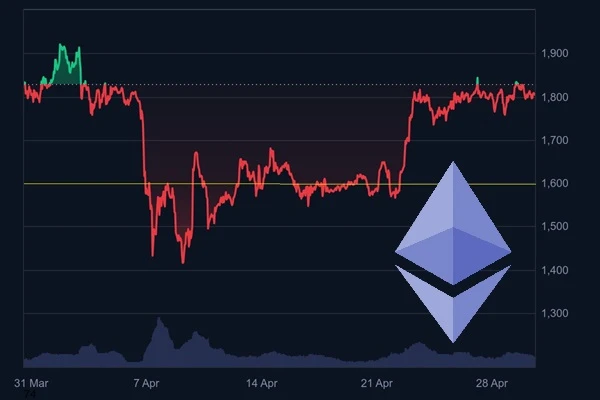

A Month of Tests: Higher Lows Amid Macro Shocks
April’s turbulence began with a 13% plunge on April 6, when ETH fell to $1400, its lowest since December 2022, driven by U.S. President Donald Trump’s 25% tariff announcement, which slashed $800 billion from crypto markets. ETH recovered above $1600 by April 9 but faced renewed selling pressure, testing $1400 again on April 14, 16, and 20, with a brief dip to $1385 on April 22. Despite these dips, higher lows signal cautious buying, though failure to sustain above $1800 keeps bulls on edge.

On-Chain Insights: Declining Activity, Whale Accumulation
On-chain data paints a mixed picture. CryptoQuant reports daily active addresses dropped to 293,000 from 717,000 in January 2025, with transaction fees at a five-year low, reflecting reduced network demand. DeFi total value locked (TVL) fell from $58 billion to $46 billion, as Layer 2 networks like Arbitrum and Base siphon activity. However, whale accumulation offers hope: Lookonchain reported $1.8 billion in ETH outflows from exchanges in early April, the largest since 2022, suggesting long-term holders are buying dips. The “7 Siblings” group acquired 25,100 ETH at an average of $1700, hinting at a potential bottom.
Technical and Competitive Pressures
Technically, ETH’s $1800 level aligns with the 50-day EMA, a historical resistance. A bearish flag pattern and RSI at 42.29 indicate weak momentum, per CoinCodex. If $1800 holds as resistance, ETH could retreat to $1600, forming a $1600–$1800 range. A breakout above $2000 could target $2400, but analysts see this as unlikely without a catalyst. Competition from Solana, Tron, and Avalanche, which offer faster transactions, adds pressure. Solana’s TVL has surged, while XRP surpassed ETH in fully diluted market cap. Could Ethereum’s declining 7.18% market share signal a longer-term shift?
Market Awaits a Spark
The crypto market is stalled, awaiting clarity on Trump’s tariffs, which sparked a risk-off wave. A potential tariff rollback, hinted at on April 9, could trigger a relief rally. The Pectra upgrade, set for May 7, 2025, aims to boost scalability, but low base-layer fees, averaging $0.16, raise sustainability concerns. Institutional interest via spot ETH ETFs remains tepid, with zero net inflows since March, as reported by Bloomberg. The Federal Reserve’s stance on 2.8% inflation projections for Q2 2025 will also influence risk assets.
Broader Crypto Struggles
Other cryptocurrencies are faltering. Bitcoin (BTC) hovers below $80,000, facing resistance at $85,000, with ETF inflows slowing. Solana (SOL) dropped 7% to $138, risking a fall to $122 if support breaks. Cardano (ADA) and NEAR lost 8–10%, reflecting market-wide weakness. The Crypto Fear and Greed Index at 20 signals fear, yet some traders are buying ETH at $1550–$1700, citing historical patterns. Despite a long-term bullish trend, short-term momentum is fading, with bears gaining traction.
Outlook: Range-Bound or Rebound?
Ethereum’s resilience in forming higher lows suggests a floor near $1600, but $1800 remains a ceiling. Without a breakout above $2000, the $1600–$1800 range may define ETH’s near-term path.
Long-term, Ethereum’s DeFi dominance and developer ecosystem, 112,535 repositories, and 2,913 weekly active developers support its value. Investors should watch tariff developments, on-chain activity, and BTC’s price, as ETH often trails its lead. For now, volatility reigns, and patience is key.
He has worked with several companies in the past including Economy Watch, and Milkroad. Finds writing for BitEdge highly satisfying as he gets an opportunity to share his knowledge with a broad community of gamblers.
Nationality
Kenyan
Lives In
Cape Town
University
Kenyatta University and USIU
Degree
Economics, Finance and Journalism


Facts Checked by Vlad Hategan

 Fact checked by
Fact checked by 
 eabungana@gmail.com
eabungana@gmail.com 